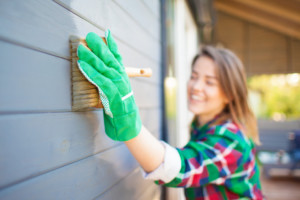Wondering how often to paint a house? Take a look at these signs your home is in need of a fresh coat of paint and what to do next.
Many people take great pride in owning a home. You can often tell by the upkeep of the home and how well it’s maintained.
But while many people might pay attention to the look of their garden, new windows, doors, and the like, it’s equally important to give attention to painting.
If you’re thinking about repainting your house, but you’re not sure if it’s time, keep reading to find out how often to paint a house.

Signs You Should Paint Your House
Painting your house can bring new life to both the interior and the exterior of your home.
For the exterior, it adds a new depth to your curb appeal. Painting the indoor makes it a whole new space, like a blank canvas to rearrange or decorate.
But how do you know when it’s time to paint the house – both the exterior and the interior?
Here are some guidelines to follow for painting your house.
Exterior
Painting the exterior of your home, in some cases, can be tricky and dangerous and best left to the professionals. In any case, here are some tips on whether or not you need to run to the nearest hardware store for a new coat of paint.
1. Damage
If there is clear damage to the surface of your home, it likely means there’s a larger problem. Cracks or rotting indicate there’s something that needs to be addressed, so fix those problems first before you choose a new exterior color.
Each house has a different surface, and there are lengths of time when the surface is likely ready for a fresh coat.
Here is a good guideline to help:
Brick: 15-20 years, but cleaning frequently
Wood: 4-7 years, but more so if it’s stained
Stucco: 5-7 years or as needed
Aluminum siding: up to 5 years.
While these numbers are a ballpark range, assess your siding and materials properly to decide if a paint job is needed.
2. Fading
All paint fades, but if it begins to fade significantly, it’s time to grab a paintbrush. Darker colors fade more quickly than lighter or neutral colors, so consider that before selecting a new hue.
3. Peeling, Chalking, and Morphing
All of these, peeling, cracking, and morphing, cause the paint to look run down and ruined.
Environmental factors like harsh weather conditions and extreme temperatures, can all contribute to peeling. If the paint is of high quality, it should not peel.
Chalking is a term used to refer to the residue that’s left on your hands if you run your hand over the paint. If it leaves behind a chalky texture, then it’s time to repaint.
Morphing is when patches of the paint turn a different shade entirely. This makes the paint job look splotchy, and usually occurs because of UV rays.
4. Bubbles
Bubbles might be fun in a bath, but you don’t want to see them on your wall. Bubbles and cracks are a sure sign of mold and rotting, so repainting and mold extraction is needed.
5. It Looks Bad
There’s no shame in admitting that a color you choose did not turn out as you expected! If you painted your home, and it leaves a bad taste in your mouth, consider repainting to something more tasteful.
Interior
Reasons for painting the interior of your home are similar to painting the exterior: fading, damage, mold, peeling, cracking, and so forth. However, there are a few differences.
1. Scratches or Scuffing
The inside of your home is more prone to scratching and scuffing damage, especially if you have a family or animals. High-traffic areas are more likely to be scratched, like living areas, hallways, or mudrooms, but painting over them can give your room a much-needed touch-up.
Remember, if the damage is deep, like a hole in the wall, repair the damage first, and then repaint.
2. Moving
If you’re moving, and your walls are personalized with a color you love, you should probably consider repainting them. Homes sell quickly when the walls are painted a more neutral color. You want the homeowners to imagine themselves in the home, and neutral colors are perfect at doing so.
3. Dislike For The Color
Sometimes it happens: despite your best efforts and decision-making, you choose a color you end up hating. That’s ok. Repainting is often one of the easiest ways to change the look and feel of a room.
4. Remodeling
Are you knocking down walls and rebuilding? Unless you love the look of drywall, it’s time to choose a new color! Remodeling offers you a blank canvas and plenty of choices for a new color.
Things to Remember When Painting
Painting is much more than choosing a color and painting the surface. There are a few things to consider.
Prepare
Think about the surface you’re painting, and whether it’s indoors or outdoors. There are certain types of paints that are formulated to withstand each environment.
You’ll also need to repair any damage before you put on the first coat. This could take several days depending on the severity of the damage.
Pick
Select your paint color! Remember, darker colors are more likely to fade, and if you’re moving, try and find a neutral color.
If you plan on staying for a long period, visualize the space you want to create and choose accordingly.
Paint
Now it’s time to paint! Gather your materials – paintbrush, tarp, paint, and so forth – and start painting.
Painting the exterior could mean calling on a professional if the job is too treacherous.
How Often to Paint A House
When it comes to how often to paint a house, it’s going to depend on the amount of damage, fading, and personal preference. Assess your situation, and watch your space transform.
Thinking about painting and need professional help? We take care of all the work! Contact us today to get a quote!
